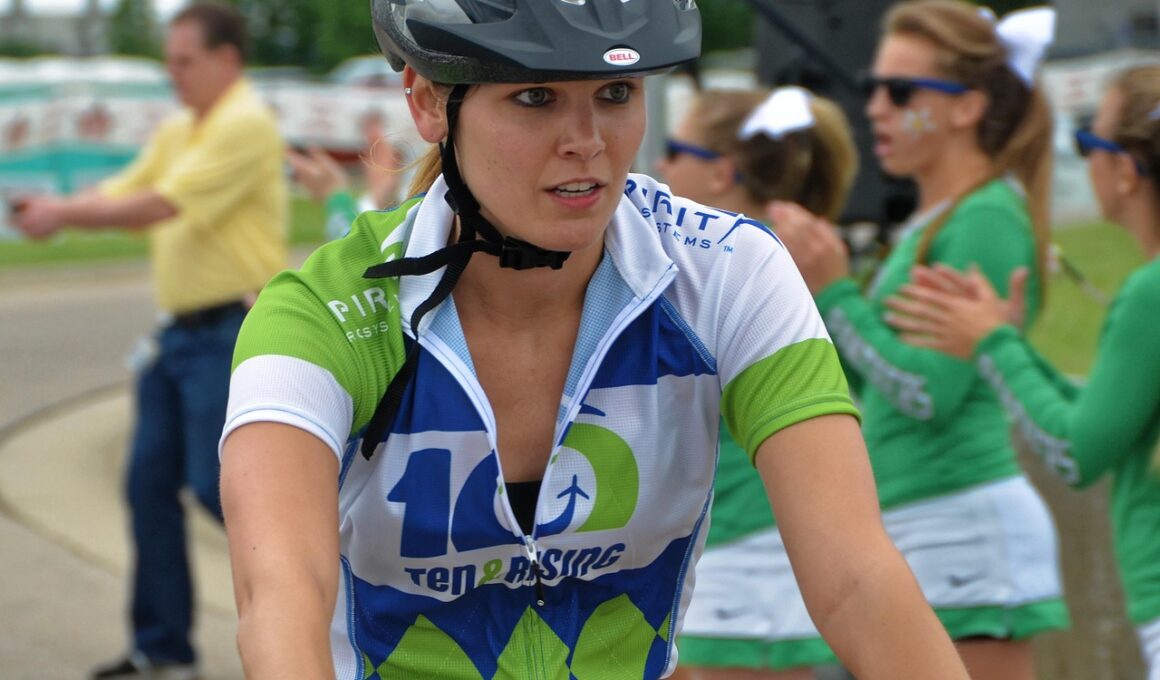Customizing Your Bike Fit for Different Riding Styles
Bike fitting is an essential aspect of cycling that can significantly improve performance, comfort, and reduce the risk of injury. A proper bike fit takes into account various factors, including the rider’s body dimensions, flexibility, and riding style. Different categories of cycling, such as road, mountain biking, or spinning, necessitate unique adjustments to the bike. Road cycling demands a more aggressive position for aerodynamics, whereas mountain biking often requires an upright stance for better control. Spinning presentations often focus on intense efforts in a stationary setting, leading to an in-between fit style. When fitting your bike, focusing on pedal stroke optimization, saddle height, and handlebar height is critical. These elements affect comfort levels and the overall enjoyment enjoyed during rides. Understanding your riding style will assist you in making appropriate adjustments. The investment in a professional bike fitting can enhance efficiency and add to the riding experience. Additionally, various online resources provide guides and tools for those who prefer a DIY approach to achieve an adequate fit. Whether you’re a casual rider or a performance enthusiast, prioritizing bike fit is indispensable for your cycling experience.
Understanding Body Geometry
Individuals come in various shapes and sizes, and understanding body geometry is pivotal when customizing your bike fit. Your leg length, torso length, and arm span all contribute to how well you fit onto your bike. A professional bike fitter will typically assess these measurements and recommend adjustments based on your dimensions and riding style. Different riding styles further influence the required bike geometry. For example, a road cyclist usually prefers a longer reach than a mountain biker, who needs more upright geometry to handle rough terrain. Riders also need to consider their flexibility, as some individuals are capable of adopting more aerodynamic positions than others. This flexibility impacts saddle height and fore-aft positioning as well. Oftentimes, bike fit for spinning instructors necessitates a middle ground between these extremes. Riders should pay attention to saddle width and comfort as well. Ensuring that the saddle fits properly can prevent discomfort during prolonged rides, making adjustments according to body geometry important. Ultimately, understanding your body’s geometry allows you to customize the bike fit to suit your individual requirements and enhance your overall experience when riding.
The importance of saddle position cannot be overstated when focusing on bike fitting. Achieving an optimal saddle height is crucial for a smooth pedal stroke and minimizing the risk of knee injuries. When the saddle is positioned too low, it can cause strain on your knees, while a seat that is too high can lead to poor power transfer. Ideally, the leg should have a slight bend when the pedal is at the bottom of the stroke. Alongside height, fore-aft position is just as important, as it influences hip and knee alignment during pedaling. If your saddle is too far forward, you may find yourself overextending your knees, whereas a saddle that’s too far back can interrupt power transfer. Additionally, taking the time to analyze your saddle width ensures comfort, which plays an integral role in ride quality. Don’t forget to factor in the riding style as well; a road bike fit might differ from a mountain bike fit significantly. By understanding and optimizing the saddle position, riders can maximize their performance, maintain comfort, and minimize fatigue on longer rides, enriching their cycling journey.
Handlebar Height and Reach
Handlebar height and reach are crucial elements to consider when fine-tuning your bike fit. The position of the handlebars affects your overall posture and can drastically impact riding comfort and efficiency. A general guideline for road cyclists is to have the handlebars at the same height or slightly lower than the saddle to maintain an aerodynamic position. On the contrary, mountain bikers often prefer higher handlebars for improved control and maneuverability. While adjusting bar height, keep in mind your flexibility and preferences toward riding styles. An adjustment of the stem length may combine with changes in handlebar height to provide the best reach for your unique fit. If you perform high-intensity rides, such as spinning sessions, a moderate reach provides a balance of comfort and performance. Moreover, monitoring hand positioning on the bars can prevent discomfort during extended rides. Riders may find it beneficial to experiment with bar positions while adapting to varying terrain. Ultimately, a proper understanding of handlebar height and reach permits riders to tailor their bike fit uniquely, establishing a connection with the bike, leading to improved performance and pleasure throughout the journey.
Pedal and cleat positioning are often overlooked but essential aspects of a proper bike fit. To achieve an efficient pedal stroke, alignment between the pedals, and the rider’s foot position must be optimized. Using clipless pedals can enhance performance and control; however, placement of the cleats is critical for ensuring the knees track properly during pedaling. Incorrect cleat positioning can result in discomfort or overuse injuries, including patellar tendinopathy or iliotibial band syndrome. Each bike style, from road cycling to indoor spinning, requires careful attention to pedal and cleat setup. As a general rule, your cleats should reflect your natural foot position when standing; this ensures that when you clip in, the power transfer is efficient. You may also want to experiment with different positions to assess comfort levels, especially when riding more demanding terrains. Furthermore, aiming for a slight outward angle, typically around 5 degrees, may alleviate potential knee strain. By making the necessary adjustments to pedals and cleats, riders can experience a smoother cycling experience while significantly reducing the risk of injury during extended rides.
The Role of Professional Fitting Sessions
If one seeks the best results from their bike fit, consulting a professional is highly recommended. Professional bike fitters possess extensive knowledge and tools designed to analyze body mechanics, cycling style, and bike ergonomics. During a fitting session, the fitter assesses the rider while they perform on their bike, identifying any discrepancies that could lead to discomfort or inefficiency. This real-time assessment ensures that adjustments are personalized to the rider’s needs, unlike generic fitting methods. These specialists utilize specialized equipment such as pressure mapping and motion capture, making changes based on actual performance data. Their expertise can diagnose alignment issues and suggest modifications for efficiency improvements, leading to enhanced performance on the road or trail. Not only can they alter saddle and handlebar positions, but they can address other aspects of the fit by recommending different components, such as stems or saddles, as needed. Furthermore, an analysis of cycling-specific muscle engagement can assist in ensuring that the fit accommodates the required movements for various riding styles. Thus, investing in professional fitting is a transformative experience for cyclists of all levels.
Lastly, maintaining proper fit throughout your cycling journey is essential. As your body changes through training, flexibility improvements, or weight fluctuations, it becomes necessary to revisit your bike fit periodically. Moreover, as you delve deeper into different cycling styles, adjustments might be indicative of shifting priorities or preferences. Regularly checking saddle height, handlebar positioning, and pedal setup allows cyclists to adapt their bikes to new riding experiences effectively. Additionally, noting any discomfort during rides should inspire a fit assessment to ensure proper adjustments are made. Many cyclists may not realize that even small changes can have significant impacts on comfort and performance. Regular upkeep of fit maximizes your ride experience while mitigating potential long-term issues. Many cyclists turn to resources or even mobile apps dedicated to helping track necessary adjustments. Networking within cycling communities can provide insights and help all riders to keep their fitness levels aligned with their equipment. All things considered, ongoing attention to bike fitting is an investment in your well-being and a crucial part of enjoying the cycling experience long-term.
Conclusion
In conclusion, customizing your bike fit significantly transforms your riding experience, ensuring performance and comfort tailored to your personal style. Adequate fitting requires an understanding of body geometry, saddle position, handlebar height, pedal alignment, and the value of professional fittings. Each element must be evaluated periodically, allowing riders to adapt to changes over time, especially as flexibility and riding styles evolve. Whether road cycling, mountain biking, or participating in spinning classes, there is a fitting approach tailored to every style. Additionally, the investment in a professional fitting session can greatly enhance riding efficiency and enjoyment. Nevertheless, for DIY enthusiasts, many resources and guides exist to facilitate proper fit at home. Ultimately, the focus on bike fit should be a priority for every cyclist, as it serves as the foundation for a rewarding experience. Prioritizing fit can prevent injuries and improve overall performance. Remember also to maintain open connections within the cycling community, sharing insights and experiences. As you embark on your cycling journey, let the right fit guide you towards achieving greater heights, both in comfort and performance, as you navigate the endless possibilities cycling offers.


